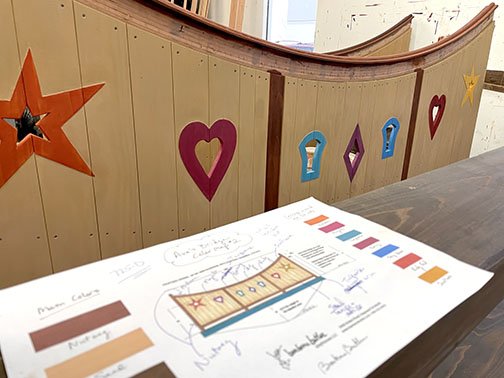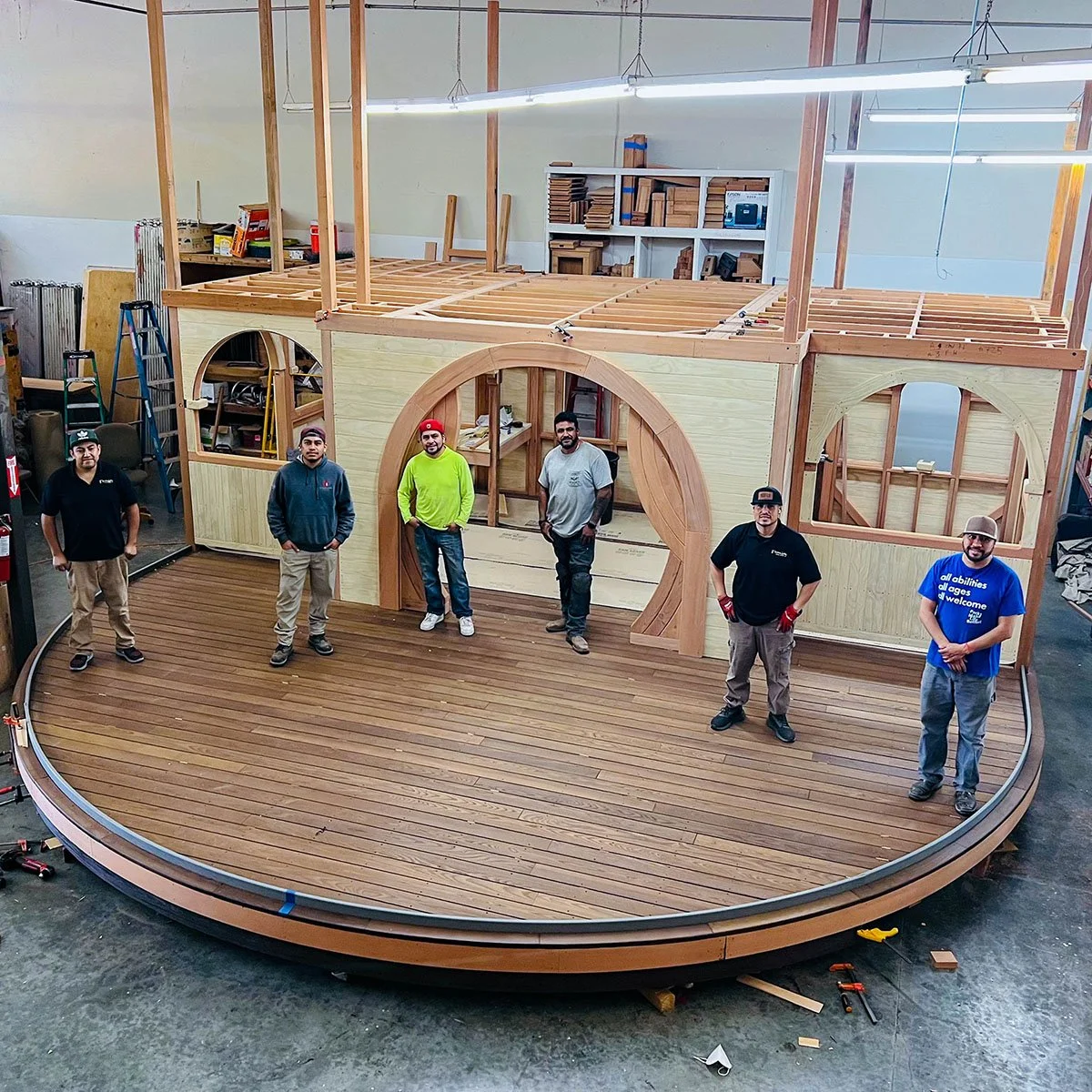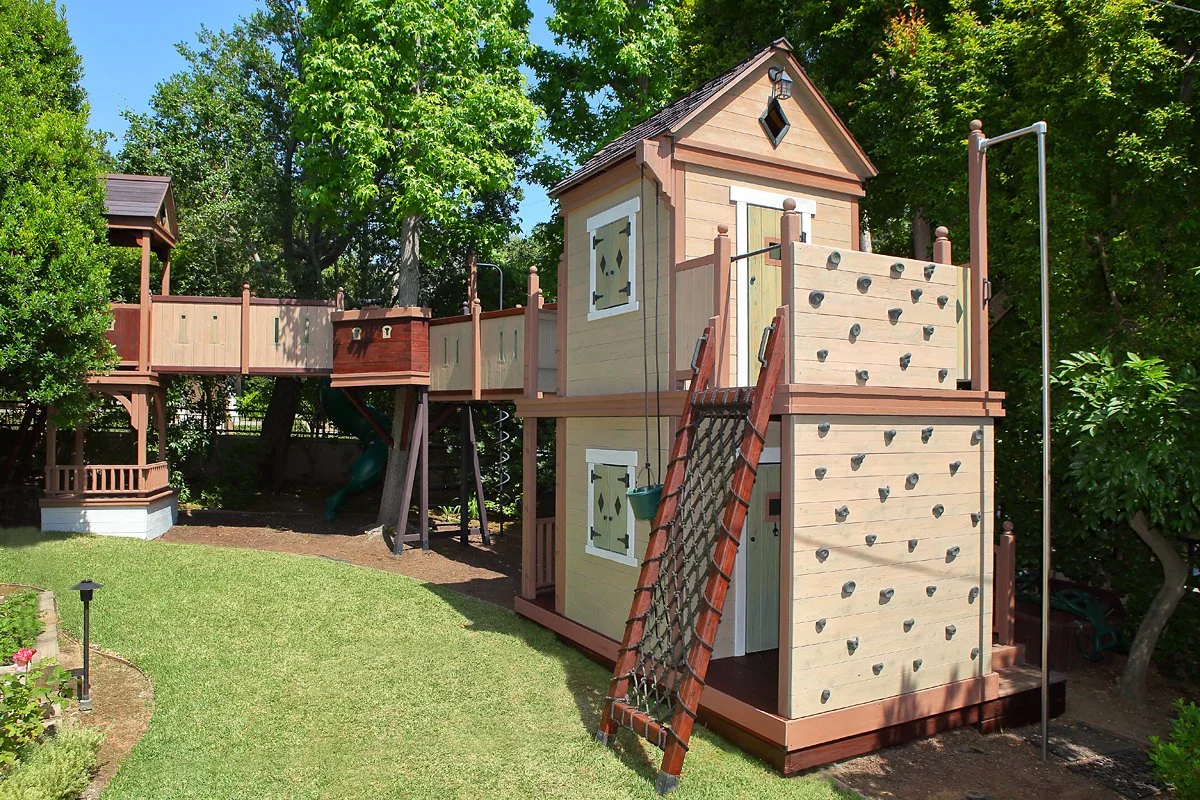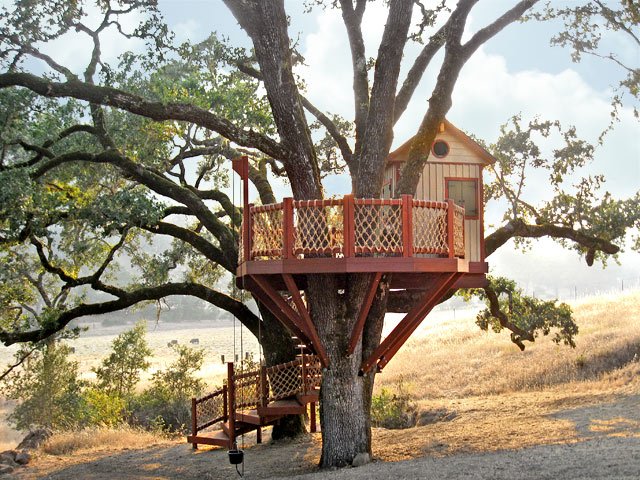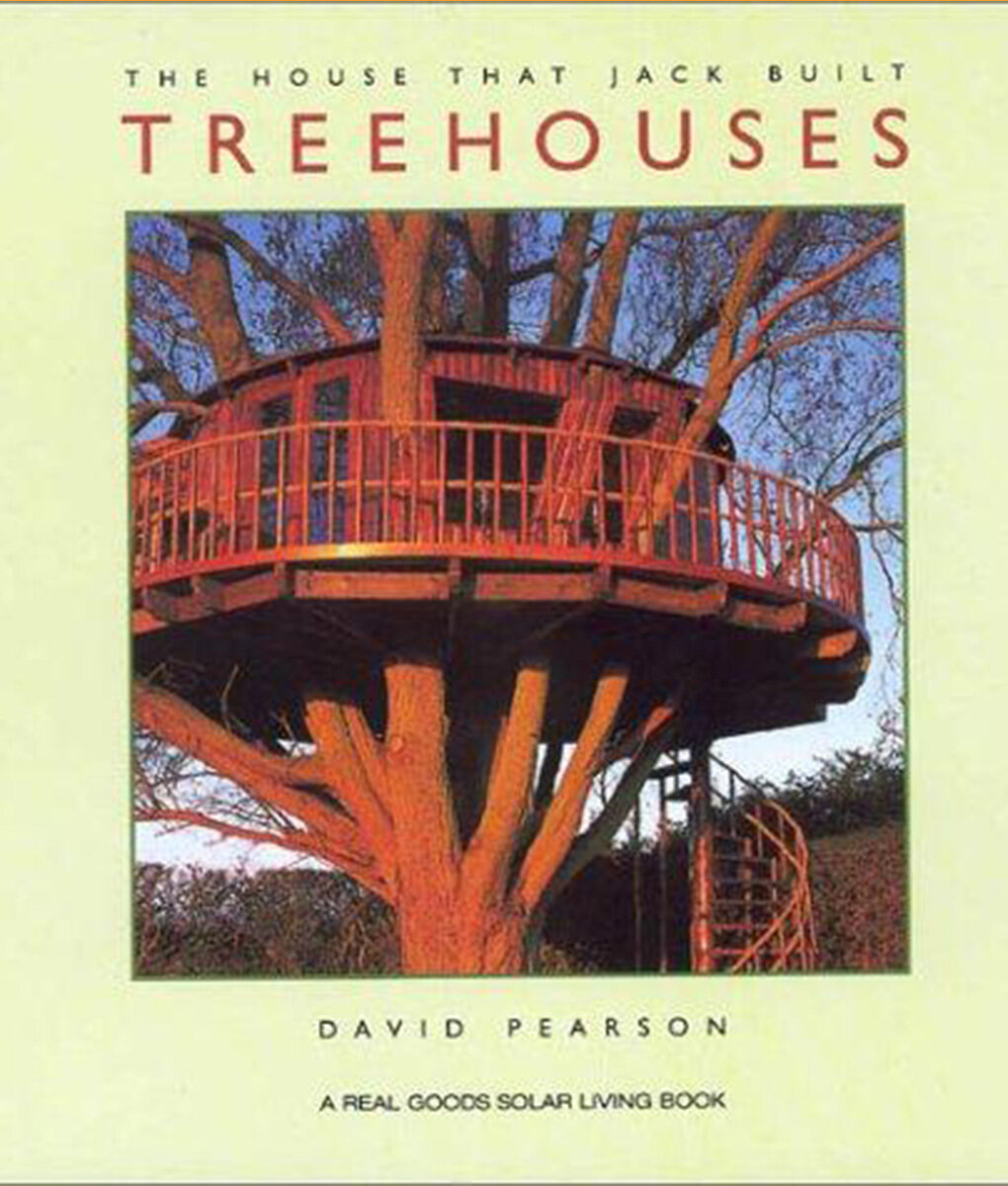Press
+ The New York Times
Child’s Play
Kate Murphy | July 21st, 2011
APART from the open bar by the swimming pool, the main attraction at parties held at the Houston home of John Schiller, an oil company executive, and his wife, Kristi, a Playboy model turned blogger, is the $50,000 playhouse the couple had custom-built two years ago for their daughter, Sinclair, now 4.
Cocktails in hand, guests duck to enter through the 4 ½-foot door. Once inside, they could be forgiven for feeling as if they’ve fallen down the rabbit hole.
Built in the same Cape Cod style as the Schillers’ expansive main house, the two-story 170-square-foot playhouse has vaulted ceilings that rise from five to eight feet tall, furnishings scaled down to two-thirds of normal size, hardwood floors and a faux fireplace with a fanciful mosaic mantel.
The little stainless-steel sink in the kitchen has running water, and the matching stainless-steel mini fridge and freezer are stocked with juice boxes and Popsicles. Upstairs is a sitting area with a child-size sofa and chairs for watching DVDs on the 32-inch flat-screen TV. The windows, which all open, have screens to keep out mosquitoes, and there are begonias in the window boxes. And, of course, the playhouse is air-conditioned. This is Texas, after all.
“I think of it as bling for the yard,” said Ms. Schiller, 40.
Some people might consider it “obnoxious” for a child to have a playhouse that costs more and has more amenities than some real houses, she conceded. But she sees it as an extension of the family home. “My daughter loves it,” she said. “And it’s certainly a conversation piece.”
Even in a troubled economy, it seems, some parents of means are willing to spend significant (if not eye-popping) sums on playhouses for their children that also function as a kind of backyard installation art.
There are a number of companies and independent craftsmen that make high-end playhouses, which can cost as much as $200,000, and come in a variety of styles, including replicas of real houses, like the Schillers’, and more-fantastical creations like pirate ships, treetop hideouts and fairy tale cottages. And many of these manufacturers report that despite the economic downturn, they are as busy as ever.
Barbara Butler, an artist and playhouse builder in San Francisco, said her sales are up 40 percent this year, and she has twice as many future commissions lined up as she did this time last year. Not only that, but the average price of the structures she is being hired to build has more than doubled, from $26,000 to $54,000.
“Childhood is a precious and finite thing,” Ms. Butler said. “And a special playhouse is not the sort of thing you can put off until the economy gets better.”
Likewise, Glen Halliday, who has a playhouse business in Portland, Me., said he has seen profits increase 15 percent annually during the recession. “We’ve been helped by the growing concern about childhood obesity and the need for active play,” he said. Business has been so brisk, in fact, that his company, Kids Crooked House, recently expanded from a 1,200-square-foot barn into a 4,000-square-foot manufacturing building.
And for those in the playhouse trade, this is high season.
“We get a lot of calls this time of year, when the weather gets warm and people want to get their kids outside,” said Patty Toner, vice president for sales for Lilliput Play Homes, in Finleyville, Pa., a company that sells playhouses on what might be considered the low end of the scale: between $4,000 and $50,000, depending on the style and degree of customization. Best sellers include a two-story Colonial-style house with a balcony and colonnaded porch, and a miniature medieval castle with turrets and secret passages.
Such architecturally sophisticated playhouses are usually custom-built on site to parents’ specifications, or prefabricated and shipped in parts for assembly by parents or the handymen they hire after spending several frustrating hours trying to do it themselves.
Continue to Article
+ The San Francisco Chronicle
Her Work is All About Play
Terry Nagel | March 31st, 1999
When she was growing up, Barbara Butler never had to worry about finding someone to play with. She had seven brothers and sisters, and her mother ran a nursery school. "The spirit of play was pretty strong in our family," she says with a laugh. But when she and her sister played with Barbies, she recalls, "I would spend all my time making the Barbie mansion then never wanted to play with the dolls." Now the San Francisco designer creates play structures that bring out the spirit of fun in other people. Her imaginative edifices range from storybook cottages to romantic castles, spirited pirate ships and even a lifesize lighthouse. Word of mouth has brought her some famous clients, including Kevin Kline and Phoebe Cates, who commissioned her to build a two-towered structure with a swinging bridge and wraparound ramp. Singer Bobby McFerrin hired her to build a two-story fort with carved totem poles, a tire swing and a rope ladder. Robert Redford asked her to create a "global village" play area for his Sundance resort. Butler built a 17-foot lighthouse in Malibu for record producer Lou Adler. And she recently finished installing a 18-foot-tall lookout tower for "Bicentennial Man," a Walt Disney movie starting Robin Williams that is currently being filmed in Woodside. The largest playhouse she's built is called the "Connecticut Castle." Created for a multimillionaire's two young sons in Litchfield, Conn., it includes three towers, two bridges, a mad scientist's chamber, rockclimbing wall, hand-carved gargoyles and a jail with a secret escape tunnel. The boys can descend on a 36-foot-long slide that passes under the main tower or on a 100-foot zip-line cable that runs from the main tower into the woods. Although that large castle cost $70.000, Butler's custom play structures start at $14,000. And she recently began offering four playhouses by mail order at more reasonable prices, along with undersize furniture. At the upper end of her mail-order collection are her "Cape Codder" and "Robin Hood Fort." The "Cape Codder" has three levels, a cedar shingle roof and a small balcony. It measures 4 by 6 by 10 1/2 feet and costs $8,500. The two-level "Robin Hood Fort" includes a climbing wall, a rope ladder, a mad scientist's panel, a working flagpole and a small zip-line cable ride. It measures 4 1/2 by 10 1/2 by 13 feet and is priced at $9,500. Prices range from $2,395 to $3,695 for her "Storybook Playhouse" and "Garden Playhouse," which are decorated with imaginative carvings of animals, flowers, planets and stars. Both are available in three sizes: small (4 by 4 by 7 feet), medium (4 1/2 by, 4 1/2 by 8 feet) and large (5 1/2 by 5 1/2 by 9 feet). Like her other pieces, the small playhouses are handcrafted and cheerily painted in bright colors. She often accommodates requests to make an animal look like a favorite pet. To decorate the inside of her playhouses, Butler offers whimsical painted furniture: a small-proportioned table with two chairs for $395 anda hutch for $495. What more could a kid desire? It's hard to imagine. Whatever a child - or adult - may fancy, Butler is willing to build. Her favorite assignment, she says, is "anything new that anyone dreams up."
Continue to Article
+ The San Francisco Chronicle | 2010
Barbara Butler's Tree Houses Hold Quality, Fun
Sam Whiting | July 4th, 2010
If in need of a tree house, you can climb up and try to build it, at risk of killing either yourself or the tree, leaving the job unfinished and blighting the yard. Or you can call Barbara Butler, who will get the job done in a week flat. Butler, 54, works out of a studio in South San Francisco. On job description: I call myself an artist-builder. I am a general contractor, but there is no specific license required to build tree houses, although I am a certified playground safety inspector. On clientele: We make play structures for kids. It's not that I'm opposed to tree houses for adults. It's just that I'm more interested in kids and play and getting kids out of the house and into the backyard. On definition: A tree fort has no roof and no windows, and a tree house has roof and windows. We build both. On price: It is hard to do anything in a tree for less than $15,000, and they go up from there. Ground structures start at $4,000. On house calls: Most people find us through our Web site, www.barbarabutler.com, or somebody tells them that we're the tree house people. They might send a picture of their tree. If it is local, I go over and see them, and we look at the tree and we talk about possibilities. On staff: We are the merry band of play professionals. Most of my family works here: My sister, my husband, my brother, my niece. Those are the full timers. I have seven brothers and sisters and eight nieces and nephews who help out when I'm in a jam. We're all from way upstate New York, Watertown. I moved out here 25 years ago, and everybody slowly followed. On process: All our play structures are built with redwood. The lumber comes in, then we grind it to get the splinter out, then the tree house gets built, then stained, then detailed. Then we take it apart and put it on the truck. If it is in the United States, my husband, Jeff Beal, drives it. I've built them in France and Korea. On production: We all fly in and rent a house for a week. We stock it full of food and beer and work 12- to 14-hour days. If it's in the Bay Area, we don't tend to have dinner and sleep over at each other's houses. We always get the installations done in one week. It's kind of a loose network of artists that work with me. On quality: We make all our own rope. Our welder retired, so we bought all his equipment and we do all the metalwork. Our color guy retired, so we bought all his equipment and make our own colors. We don't have a forest to grow the trees yet. On quantity: I have over 500 original designs out there, play structures and tree houses. I don't really distinguish between them. I like the designs to go with the character of the house and the property, but I am not into matching them. On charity: We donated a play structure, and these very nice people bought it at an auction. They asked us to build a kids' garden shed for the Boys & Girls Club in east Menlo Park. It is used like crazy, and they can store stuff in it and lock it up at night. On pedigree: I have noticed in real estate listings that it says, 'Has a Barbara Butler playhouse in it.' The first time I saw that, I was a little excited. On home: I've lived in the same apartment in the Mission for 23 years. I have a back deck about the size of this conference table. You couldn't build a tree house on it. That's why I borrow everyone else's yards - to amuse myself.
Continue to article
+ The San Francisco Chronicle | 2002
By Julie Dear | Spring 2002 |Washington Post Staff Writer
For Barbara Butler, playhouses are serious business. Drawing on her own childhood growing up with seven brothers and sisters, the San Francisco-based designer and builder creates whimsical confections worthy of the most active imagination: trapdoors, jail bars, swinging ropes, peepholes, escape hatches, fireman's poles. All that creativity doesn't come cheap, but Hollywood, design magazines and a growing number of people across the country have added their names to a waiting list of clients eager to play. For five years, David & Marcia Kaplan of Bethesda, MD held onto a picture of one of Butler's houses torn from a 1995 Architectural Digest. This spring, their back yard became home to a 16-foot-high "play-castle". "It's not just a kid's zone anymore," says Butler, whose work was featured in the Robin Williams movie "Bicentennial Man." "It is where the future is--so the whole family can have fun together." Samantha Kaplan, inside Fort Bethesda, and Emily Nordstrom give the new playhouse a trial run. The Kaplans agree. "We saw this picture before the house was even built," says Marcia Kaplan, a lawyer in the District. Once their stone and cedar-shingle house was finished last summer, they contacted Butler about adding a backyard fantasy playhouse for their four children. The older boys, Zack, 14, and Dan, 11, were delighted that their years of lobbying were paying off. Six-year-old twins Samantha and Jack chimed in with ideas about what features and colors to include. The result is Fort Bethesda, a 25 1/2-foot-long, two story play space built of redwood stained forest green and bright yellow with cedar doors stained red. Playhouses are "not just for kids' zone anymore" A seven-foot-square tower topped witha peaked roof has a shuttered window in front, a window with jail bars ("One of our most popular options," Butler says. "Kids are really into the jail theme."), a tiny escape door in the back, a ladder under a sliding trap door, and a mailbox for "love notes or secret messages." Each arched door has a sliding peek window that Butler calls a "who goes there." Climbing over and through the structure offers a maze of possibilities. "There are easy ways up and hard ways up," says Butler, "but quick ways down." One of the hard ways up is a side wall pocked with handholds and toeholds. "We order the stones from a rock-climbing magazine," Butler says. "They can be positioned with the indentations facing up for easy gripping or down to raise the difficulty." To get back to the ground, choose theblue tube slide or the stainless steelfireman's pole. A walkway above the swings leads to a second tower, a four-foot-square fort with a brass-knockered door and a rope net attached to a parapet above. There's a working flagpole with three flags-- a pirates' skull and crossbones, the Scottish lion victory flag "and the white flag of surrender, just in case." The belt swings are designed with heavy-duty chains and hardware rated for up to 300 pounds. "Even as they get older," Butler says, "the swings are where they come back to, to sit and swing. Swings are where serious conversations happen." The Kaplan children added another idea, says Butler. "A dumbwaiter up to the top floor, so we put in a pulley line and bucket, so the twins' request for drinks up top would be easy." Butler says her designs draw on childhood memories of growing up in a big family in Upstate New York. "We had a terrific rope swing in an old tree. And two metal bars at different heights, like chin-up bars. There was a three-foot-high rock wall around part of the house that we could pretend was a ledge next to a lava pit when we were learning to climb." She started out studying political science in college ("my mother wanted me to be a lawyer"), but after graduation learned bricklaying and construction from an older brother, James, who was a contractor renovating houses on Capitol Hill. After an intermission in graduate school, she moved to San Francisco in 1983 and started a company called Outer Space Designs with a friend. "We specialized in decks, hot tubs and fences but did not even think of play structures." Singer-songwriter Bobby McFerrin hired the duo to build an elaborate deck, and his wife, Debbie, asked for a playhouse. "Once I had done one, another couple saw it and become interested, and it just started snowballing from there." Her company, Barbara Butler Artist -Builder Inc., is co-owned with her sister Suzanne Butler, and her husband Jeff Beal, who grew up in Potomac. The firm has grown to 13 employees and usually has about eight projects going at once. Her work was included in "The Treehouse Book" by Peter and Judy Nelson with David Larkin published in June (Universe, 224 pp., $25). She displays her designs at garden shows across the country, including Washington, Richmond, and Charlotte, and on her website, www.barbarabutler.com. "I watch what the children play on during the shows," she says, "and it gives me more ideas." Butler's play structures range from portable models starting at $2,400 to custom fantasy spaces in the $16,000 plus range. The Kaplan's spent about $40,000. While Butler agrees that's a lot to spend on a playhouse, she points out that it's often less than building a family-room addition. Plus, "it gets people into an outdoor room, in their yard, and being active together." At a recent garden show in Santa Monica, Calif., actors Jada Pinkett Smith and Will Smith picked out an intricately carved and painted Storybook cottage for a house they are building in Los Angeles.
+ The Los Angeles Times
Barbara Butler on creating welcoming play spaces for kids
Lisa Boone | May 21st, 2014
Addictive smartphones, tablets and video games are no concern to San Francisco designer Barbara Butler, who has been building custom forts and treehouses for more than 25 years. “I love play and I love exercise and I love being active,” Butler said recently. “I grew up in a big family with eight kids, and we were always going out to play. All kids need is a little encouragement.” With the end of school and summer approaching, we asked Butler for some tips on how to create welcoming play areas for kids and teens.
You have so much experience working with kids. What do kids request over and over again?
Kids want swings, slides and clubhouses no matter how old they are. Usually they want a slide from their bedroom. [Laughs.] I like to add interesting ways for kids to climb. Put a clubhouse up high -- but not too high -- and make it hard for them to get to. I like to design loops and fire poles where they can climb up and down. Integrate swings and slides into the site. Beware of making a space too immature. Sometimes playhouses talk down to kids. Think about it as a safe place for unsupervised play.
You clearly enjoy incorporating trees in to the structures you design and build. How do you choose a site and know that a tree is appropriate?
Usually you can tell if a tree is healthy by looking at the canopy. I always recommend clients consult with an arborist. Sometimes it’s not strong enough. If that is the case, then we make it look like the tree supports it or you can put supports near the tree and station them with concrete posts. There are specialty treehouse fasteners available by Michael Garnier, a treehouse builder in Oregon. I like to look for a site that people haven’t thought of. Or an underused spot that is not out in the open. Kids like things that are tucked away, like a hillside or above a retaining wall. I like to find the flaw of the yard and try to use it. It adds mystery and excitement.
You use only all-natural redwood. Can you offer advice on materials for someone who might want to build a structure on their own?
I don’t use pressure-treated wood. We sand and grind all the edges so the structures are splinter free. We stain with nontoxic stains and Tung oil. The slides are plastic because the kids have convinced me that they like them. It is wonderful to use real wood. I am so happy to see it come back into favor. I use it from second-growth forests and build it in a manner that can be maintained. Redwood structures can be revitalized with a little sanding and Tung oil and last for several families.
Do you think it's really a struggle for parents to get their kids outdoors to play?
Many parents have talked to me about whether they should put electricity in the playhouse. It’s better to have a place where they can’t use their iPhone. If you build something cool, the kids are going to take a break from electronics. It’s pretty easy to lure the kids outside. With the older kids, it's about involving them in the process. Let them come up with ideas. I recently created a rope hangout where four or five kids hang out every weekend. They want a secret place that is theirs and they can escape to. It’s a great thing for teenagers. They are still on your property but you know where they are. I haven’t seen a teenager yet who doesn’t like a fire pole. They go back to swings too. It’s a place to hang out and a way to touch back to your childhood. And if kids have a zip line to run and play on, it’s going to make a big difference.
What about safety?
We think about safety a lot. The biggest safety feature you can add to a play structure is resilient surfacing around the tree. Dirt is not good enough, grass and concrete are not good enough. We want to encourage people to climb, and if they take a risk we want them to bounce off that resiliency surfacing. You can find redwood bark and rubber chips at Costco or landscape stores. The other safety concern is ropes. You really don’t want to have loose rope available to kids. When we make a pulley with a bucket we tie it in a loop so no one can get it caught around their neck. We always tie ropes off at both ends. Because your play structures are custom-built, they are obviously expensive.
Any budget tips for do-it yourself types?
I think that people can do a lot of the simpler ropes and climbing ropes. Try to create a natural play area. Create a secret area with plants. Install things that encourage imaginative and physical play. It doesn’t have to be a fancy wood tour de force. Create a hideout for the kids with physical climbing areas. That’s really what they need. They want to be up high. It’s really important. Climbing is good for their brains and motor skills. I don’t like to make treehouses too fancy. I like it to be difficult to get to and rough and tumble. The kids know that they are outside of the serious adult world but they can still peer down and see that they are safe in the family yard.
+ People Magazine
Child's Play
People 207 | May, 1999 2002
When Barbara Butler first showed up for a construction job at singer Bobby McFerrin's San Francisco home in the late 1980s, she expected to renovate the house, not her career. But her Inner Child stirred when the singer's wife, Debbie, suggested building a playhouse for the couple¹s two children. "This is the job that really got us started," recalls Butler, who at the time was so poor, she'd "park a block away because I didn't want them to see our old truck." Butler isn't playing hide-and-seek with her truck anymore. Customers eagerly pay $10,000 to $75,000 for her storybook castles and elaborate spaceships. Satisfied clients include Kevin Kline and Phoebe Cates's two scamps, and a tower built by Butler is used in Robin William's upcoming fantasy Bicentennial Man. Cates calls Butler "not just a builder for hire, she's an artist," while Debbie McFerrin says Butler's work "looks like it comes from an indigenous tribe that doesn't really exist." Coming from a tribe other own, Butler, 42, was the sixth of eight children growing up in Watertown, N.Y., where dad Jim, now 81, was an insurance executive and mom Betty, 79, ran a nursery school. Early lobs such as waitressing didn't satisfy, so Butler, a graduate of the State University of New York College at Cortland, dabbled in painting and construction, eventually making custom furniture-her first piece, a table, sold for $2. Now her husband of two years, Jeff Beal, 44, helps build her projects. They have no children, but Butler says her clients are "big kids." They certainly have money to play with. "When someone says, I feel like it's a Matisse in my yard," she laughs, "that's so much better coming from someone who actually owns a Matisse.
+ Shelter Magazine
November -December 2007
Barbara Butler doesn’t construct your typical outdoor products. In fact, this South San Francisco builder of children’s playhouses and tree houses constructs products that are anything but typical. Butler usually uses heart-grade or better natural redwood lumber from second-growth well managed forests to construct these playhouses. “We are open to using other lumber products, but will only use pressure-treated wood for floor joists upon client request and they must be covered in natural wood to protect children from ever touching them,” says Butler. Depending on the size of the project, Butler says her projects usually take six to ten weeks to build, carve, stain, pre-assemble in her shop (to ensure perfect fit), detail, disassemble and load to ship. Typically, a one-story playhouse is six weeks; a two-story fort is eight weeks and a custom design is ten to 12 weeks. Most of Butler’s customers find her via the Internet or they are referred by a landscape architect who is familiar with her work. “Interested clients then e-mail requesting a brochure and/or call our shop to talk with our expert staff,” Butler says, “We review options and help them decide if they want a pre-designed playhouse or play fort, or if they want a custom design play structure.” Butler’s pre-designed playhouses start at $3,800 and her pre-designed two-story play forts start at $9,910 plus delivery and installation. Custom play structures and tree houses generally start at $20,000. Several celebrity clients helped bring attention to Butler’s business: Kevin Kline and Phoebe Cates commissioned a large play structure for their summer home in the Hudson Valley of New York. Robert Redford commissioned Barbara to design a global village play area, and Jada Pinckett-Smith purchased the Storybook play house with carved animals all over it. Producer Lou Adler decided on a dramatic lighthouse for his Malibu beachfront property. **Safety is Top Priority** Butler says that safety is a primary concern. “We make all our structures sturdy enough for kids and adults to play on together for many years,” Butler says. Butler’s primary goal is to design a fun structure that is safe and stimulating to children, as well as architecturally beautiful. Some of the extra steps she takes for safety are: grinding smooth all sides of the redwood lumber to prevent splinters, making sure there are plenty of handles and railings to keep kids from falling and the company encourages parents to install resilient surfacing material around the structure (such as rubber bark chips) to protect kids from injury in case of fall. For Butler’s public-use structures, the entire structure is designed and built to meet and exceed the CPSC and ASTM Standards for public-use play structures. Butler says they only use high-quality non-toxic tung-oil stains with artist quality pigment. “We make our own 59 beautiful colors to choose from and will custom develop a color upon request,” Butler says. “To protect the play structure, we add two coats of clear tung-oil before delivering. These stains are not harmful to children or the environment and are very beautiful. They are applied by hand, left for ten minutes and then hand-rubbed to bring up the sheen and to let the beauty of the natural wood grain show through. This is very labor-intensive but well worth the beautiful look. Also, stains just mellow with age and do not chip, bubble or peel like paint, which can be a potential hazard to children. **Happily Ever After** With proper care, Butler says her structures will last forever. Wood is an incredibly durable product—look at the number of wood houses that are hundreds of years old and still in existence,” Butler says. Butler has been building her play structures for more than 20 years and often goes back to visit them, keeping an eye on what works and what doesn’t. It is still her opinion that wood is the perfect material for kids and play structures. It is strong yet soft when you bang your head against it. It is a natural product and easy to work with: we can repair it, replace damaged pieces, re-stain it, renovate it, add to it and move it.








